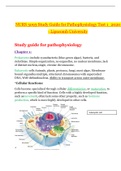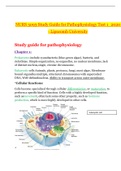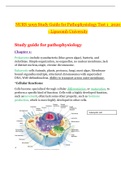NURS 3093
Lipscomb University
All 4 results
Sort by

-
Study Guide for Pathophysiology (NURS 3093 )
- Summary • 67 pages • 2022
-
- $9.19
- + learn more
NURS 3093 Study Guide for Pathophysiology Test 1_2020 - Lipscomb University Study guide for pathophysiology Chapter 1: Prokaryotes include cyanobacteria (blue-green algae), bacteria, and rickettsiae. Simple organization, no organelles, no nuclear membrane, lack of distinct nucleus, single, circular chromosome. Eukaryotic cells Animals, plants, protozoa, fungi, most algae, Membrane bound organelles multiple, structured chromosomes with supercoiled DNA, Well-defined nucleus, Ability to trans...

-
NURS 3093 Study Guide for Pathophysiology Test 1_2020 - Lipscomb University
- Exam (elaborations) • 67 pages • 2022
- Available in package deal
-
- $7.99
- + learn more
NURS 3093 Study Guide for Pathophysiology Test 1_2020 - Lipscomb University Study guide for pathophysiology Chapter 1: Prokaryotes include cyanobacteria (blue-green algae), bacteria, and rickettsiae. Simple organization, no organelles, no nuclear membrane, lack of distinct nucleus, single, circular chromosome. Eukaryotic cells Animals, plants, protozoa, fungi, most algae, Membrane bound organelles multiple, structured chromosomes with supercoiled DNA, Well-defined nucleus, Ability to trans...

-
NURS 3093 Study Guide for Pathophysiology Test 1_2020 - Lipscomb University
- Exam (elaborations) • 67 pages • 2022
- Available in package deal
-
- $7.99
- + learn more
NURS 3093 Study Guide for Pathophysiology Test 1_2020 - Lipscomb University Study guide for pathophysiology Chapter 1: Prokaryotes include cyanobacteria (blue-green algae), bacteria, and rickettsiae. Simple organization, no organelles, no nuclear membrane, lack of distinct nucleus, single, circular chromosome. Eukaryotic cells Animals, plants, protozoa, fungi, most algae, Membrane bound organelles multiple, structured chromosomes with supercoiled DNA, Well-defined nucleus, Ability to trans...
Get high quality materials for your studies in bulk at very reasonabe price.

Study stress? For sellers on Stuvia, these are actually golden times. KA-CHING! Earn from your study resources too and start uploading now. Discover all about earning on Stuvia



